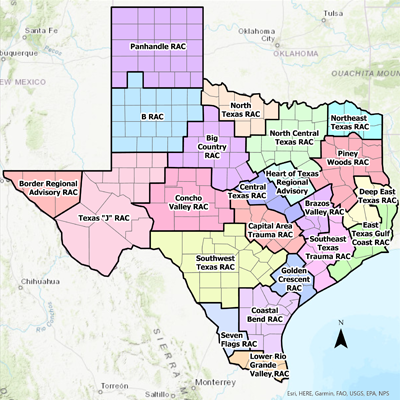History of Regional Advisory Councils in Texas
Regional Advisory Councils (RACs) were created in Texas following legislation in the late 1980s and early 1990s that recognized the need for a coordinated trauma and emergency healthcare system across the state. In 1989, the 71st Texas Legislature passed Senate Bill 792, establishing the state trauma system. By 1992, the Texas Department of Health (now DSHS) formalized the framework for RACs under Texas Administrative Code §157.123, designating each RAC to serve a specific Trauma Service Area (TSA). RACs were tasked with uniting hospitals, EMS providers, public health agencies, and emergency management under regional plans to improve trauma care, reduce preventable deaths, and coordinate system-wide emergency response.

The Origination of TRAC-V in the Rio Grande Valley
Trauma Regional Advisory Council V (TRAC-V) was formed in the early 1990s to serve TSA-V, which covers the four Rio Grande Valley counties of Cameron, Hidalgo, Starr, and Willacy. From its founding, TRAC-V became the designated coordinating body to strengthen trauma care in one of Texas’ most diverse and fast-growing regions. With a mix of densely populated urban areas and rural communities, and its proximity to the Texas–Mexico border, the Valley faced unique challenges in ensuring access to timely, coordinated emergency and trauma services. TRAC-V provided the structure to bring hospitals, EMS agencies, and community partners together under a single system to address those needs.
Milestones and Accomplishments
-
1990s – Early Formation: TRAC-V brought together the first regional working groups of hospitals and EMS agencies to establish common trauma protocols and begin pursuing trauma facility designations in the Valley.
-
2000s – Trauma System Expansion: Multiple hospitals in TSA-V achieved state trauma designation, supported by TRAC-V’s coordination of education, performance improvement, and system planning. TRAC-V also began hosting its annual symposium to provide regional education and training.
-
2010s – System Integration: TRAC-V expanded its committees beyond trauma to include cardiac, stroke, maternal/perinatal, and injury prevention, ensuring a comprehensive approach to emergency healthcare. The council also increased its role in disaster preparedness, supporting hospitals and EMS during hurricanes, public health events, and mass casualty incidents.
- 2020s – Innovation and System Advancement:
During the 2020s, TRAC-V launched several groundbreaking initiatives that significantly advanced emergency and trauma care in the Rio Grande Valley.
-
- Regional Whole Blood Program: TRAC-V coordinated the development of a regional whole blood program to ensure that hospitals and EMS agencies have timely access to life-saving blood products during trauma and mass casualty events. By standardizing storage, rotation, and utilization practices across the Valley, the program has improved survivability for patients experiencing severe hemorrhage — making the RGV one of the few regions in Texas with a fully integrated whole blood system.
-
- Integration of Pulsara for EMS-to-ED Communication and Disaster Management: Recognizing the need for faster, more reliable communication, TRAC-V facilitated the adoption of Pulsara, a secure, mobile platform that links EMS and hospital teams in real time. This innovation allows paramedics to transmit patient information, images, and alerts before arrival, expediting care and reducing treatment delays. Pulsara has also been expanded for disaster management, giving regional partners a unified communication tool during mass casualty incidents and evacuations.
-
- Regional Trauma and EMS Data Repository: To drive continuous performance improvement, TRAC-V invested in building a regional data repository that aggregates trauma and EMS records from across TSA-V. This repository aligns with national data standards (e.g., NTDB, NEMSIS) while giving the region access to more timely, localized data. The system allows TRAC-V to identify trends, measure outcomes, support research, and inform planning for both everyday care and disaster response.
Through these milestones, TRAC-V has grown into a vital leader in the Rio Grande Valley’s emergency healthcare system. Its collaborative approach has improved trauma survival, strengthened regional disaster readiness, and created a culture of continuous improvement among healthcare providers. Today, TRAC-V continues to build on its legacy by uniting hospitals, EMS, and community partners to ensure the Valley remains prepared, resilient, and innovative in the face of both everyday emergencies and large-scale disasters.
